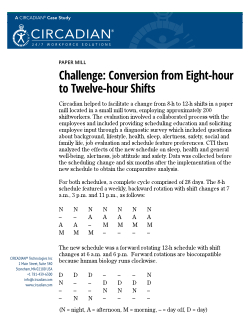CIRCADIAN® helped to facilitate a change from 8-h to 12-h shifts in a paper mill located in a small mill town, employing approximately 200 shiftworkers. The evaluation involved a collaborated process with the employees  Click image to download pdfand included providing scheduling education and soliciting employee input through a diagnostic survey which included questions about background, lifestyle, health, sleep, alertness, safety, social and family life, job evaluation and schedule feature preferences. CTI then analyzed the effects of the new schedule on sleep, health and general well-being, alertness, job attitude and safety. Data was collected before the scheduling change and six months after the implementation of the new schedule to obtain the comparative analysis.
Click image to download pdfand included providing scheduling education and soliciting employee input through a diagnostic survey which included questions about background, lifestyle, health, sleep, alertness, safety, social and family life, job evaluation and schedule feature preferences. CTI then analyzed the effects of the new schedule on sleep, health and general well-being, alertness, job attitude and safety. Data was collected before the scheduling change and six months after the implementation of the new schedule to obtain the comparative analysis.
For both schedules, a complete cycle comprised of 28 days. The 8-h schedule featured a weekly, backward rotation with shift changes at 7 a.m., 3 p.m. and 11 p.m., as follows:
| N | N | N | N | N | N | N |
| – | – | A | A | A | A | A |
| A | A | – | M | M | M | M |
| M | M | M | – | – | – | – |
The new schedule was a forward rotating 12-h schedule with shift changes at 6 a.m. and 6 p.m. Forward rotations are biocompatible because human biology runs clockwise.
| D | D | D | – | – | – | N |
| N | – | – | D | D | D | D |
| – | – | – | N | N | N | – |
| – | N | N | – | – | – | – |
(N = night, A = afternoon, M = morning, – = day off, D = day)
The pre and post-implementation results confirmed that the conversion to a 12-h schedule was quite positive. The change was well received by the employees, who reported positive impact on different issues. As expected, the change was beneficial for their family and social life, providing more time off. Several health issues also showed an improvement after the change, such as a decrease in the frequency of sleep problems, fatigue (from 37% to 20%), back pain (from 40% to 24%) and digestive disorders.
The 12-h shifts resulted in improved daytime sleep following the night shifts (longer duration and better quality). For example, the percentage of employees getting six or more hours of sleep per day while working nights increased from 46% to 63%. However, there was a slight decrease in sleep duration when working the day shift. This was due to the accompanying change in the starting time of the shifts. The morning shift started at 7 a.m. with the 8-h schedule, but the employees opted for a 6 a.m. start with the 12-h schedule. Such a change runs counter to our natural biological drift, resulting in moderate sleep loss from the difficulty in getting to sleep earlier in the evening, and waking up earlier the next morning. However, the employees were willing to deal with this for the social benefit of getting home earlier from the day shift.
Alertness levels while working were similar with both schedules, and the number of self-reported accidents decreased after the change. Regarding accidents or injuries at work, the percentage of employees who reported at least one accident decreased from 29% to 18% and those who reported near-accidents from 58% to 32%. The percentage of employees reporting near-accidents while driving decreased from 60% to 38%, while there was no difference in the reported number of accidents for 8 vs. 12-hour shifts.
The conversion to the 12-h schedule also had a positive effect on job performance and attitude. Overall, 73% of employees reported being satisfied/very satisfied with the new schedule. Approximately two thirds of employees agreed that team morale and attitude had improved (61%) and that absenteeism and turnover had decreased (57%) with the new schedule. The new schedule also had a positive impact on family/social life. The percentage of employees reporting difficulties maintaining quality of family/social life decreased from 61% to 13%.
Thus, the overall impact of the conversion to 12-h shifts was very positive. Several factors contributed to this result, and among them appears to be the type of schedules involved (previous vs. new schedule), the workload, and the process for determining and implementing the new schedule. In this case study, the change was from a weekly, backward rotating schedule to a forward rotating schedule. A large number of research studies have concluded that to minimize the disturbances of the circadian system, clockwise rotations are preferable (Knauth 1995). In addition, the 8-h schedule sometimes provided only 1 or 2 consecutive rest days between shifts, which is considered insufficient for full rest and recovery. The workload and type of task involved can also have an influence on the acceptability of 12-h shifts. In the paper mill, although there are periods of very high activity, the average workload is not excessive and employees can sometimes move around the plant and interact with each other. Other work stressors present in a paper mill, such as noise and heat, have been cited as factors that could aggravate the potential fatiguing effects of longer work periods, although they did not seem to have played a major role in this study.
It is important to consider the effects of the process used to implement the new schedule. In this study, employees were involved in the process of determining the best schedule alternatives, and then they were able to collectively vote their preference, and thus self select and take ownership in the new work schedule. Several authors have noted that employee participation in selecting the shift schedule and providing input in other job-related issues is critical for the acceptance and positive effects of any new schedule.
In summary, the change from an 8-h to a 12-h schedule was positive overall. The longer periods of days off and shorter periods of work days proved beneficial for family and social life, and they allowed for adequate recovery after the longer shifts. These results emphasize the importance of involving employees in the selection of a new schedule. It is especially important to note that when considering the change to 12-h shifts, several factors, such as workload and demographic make-up of the employee population (e.g. age, gender, marital/family status, etc.) should be carefully evaluated as part of the scheduling process.


